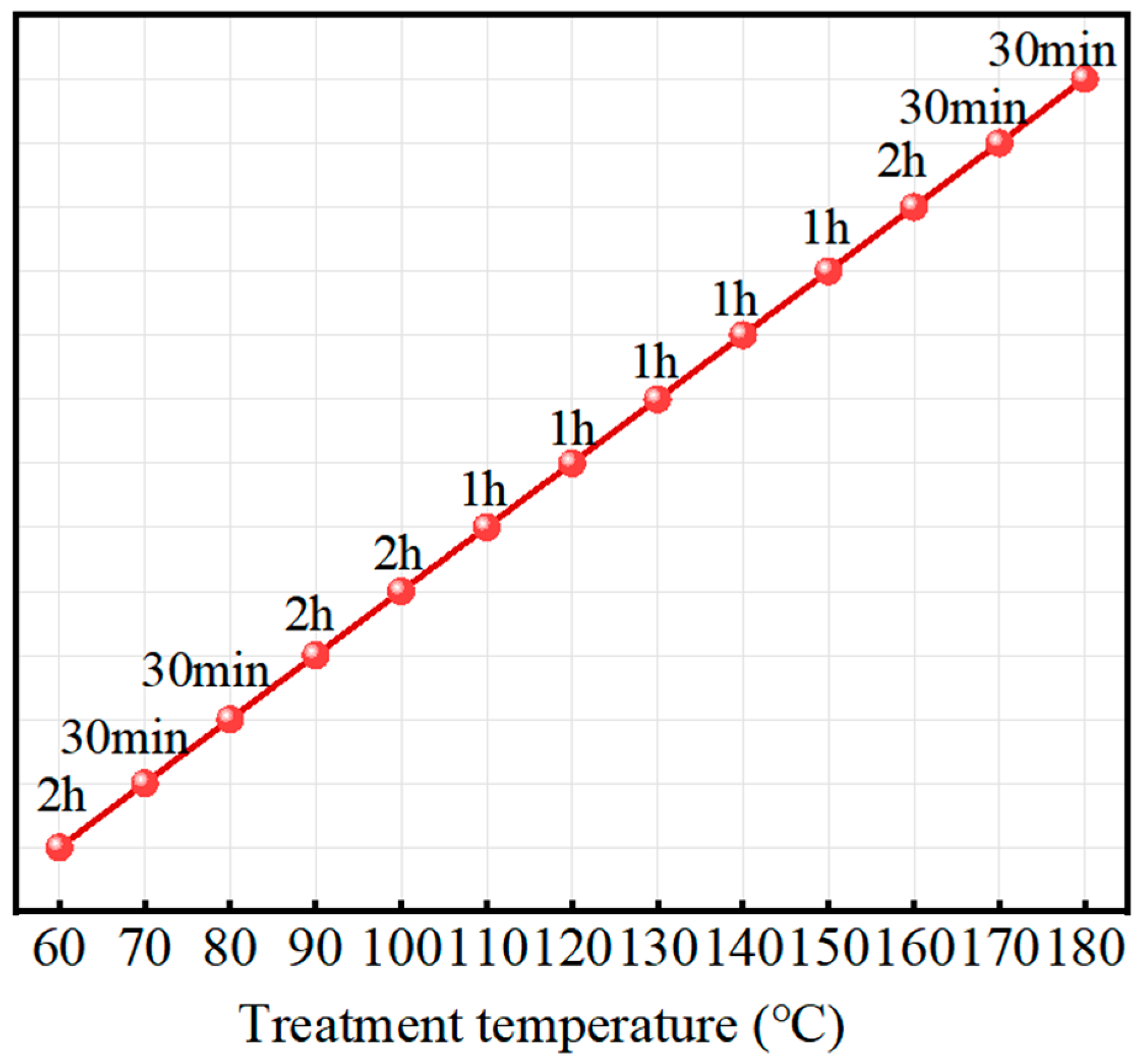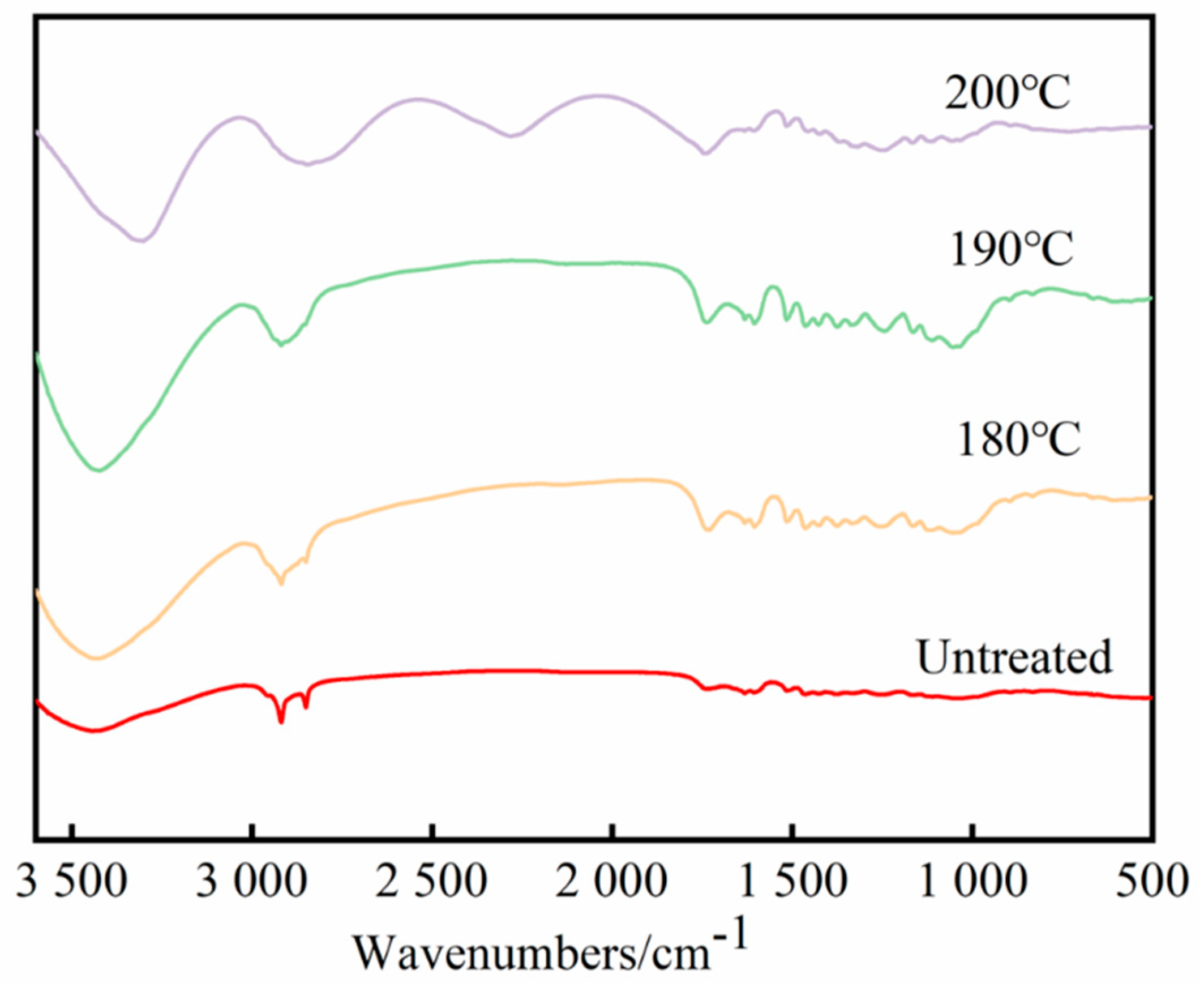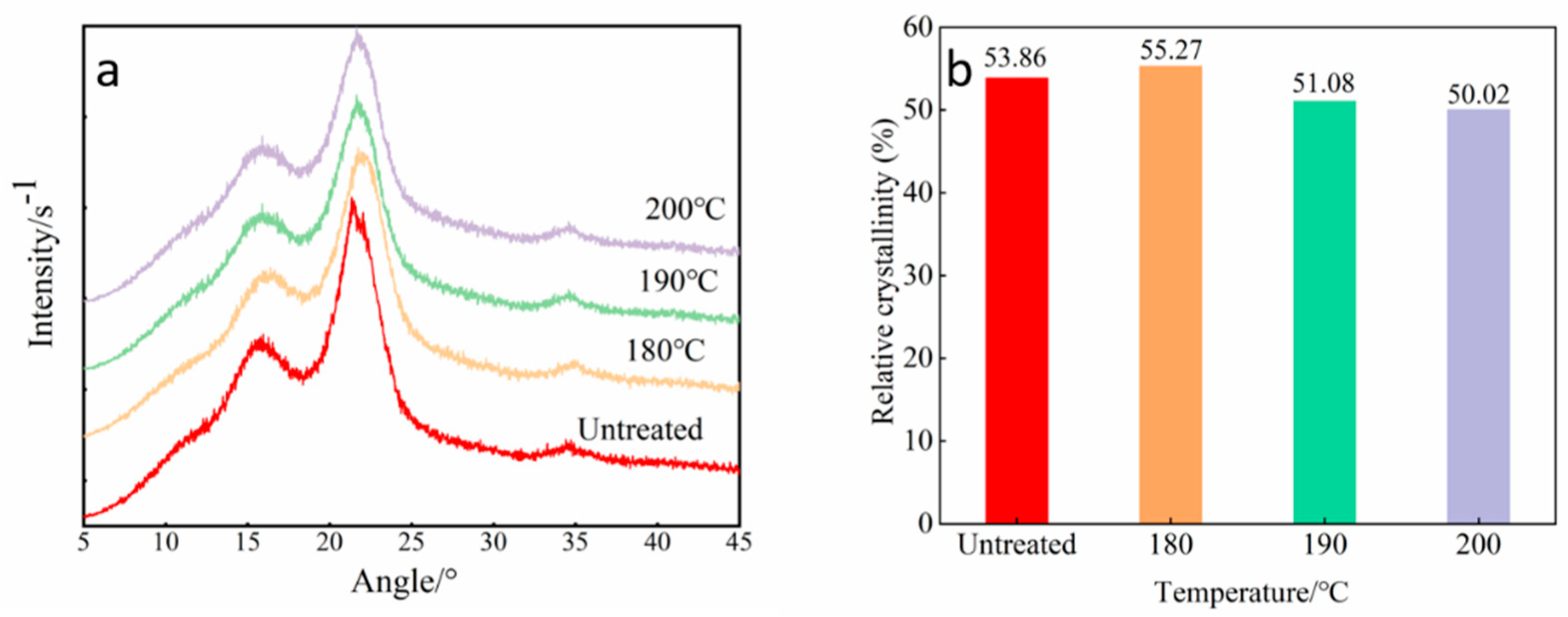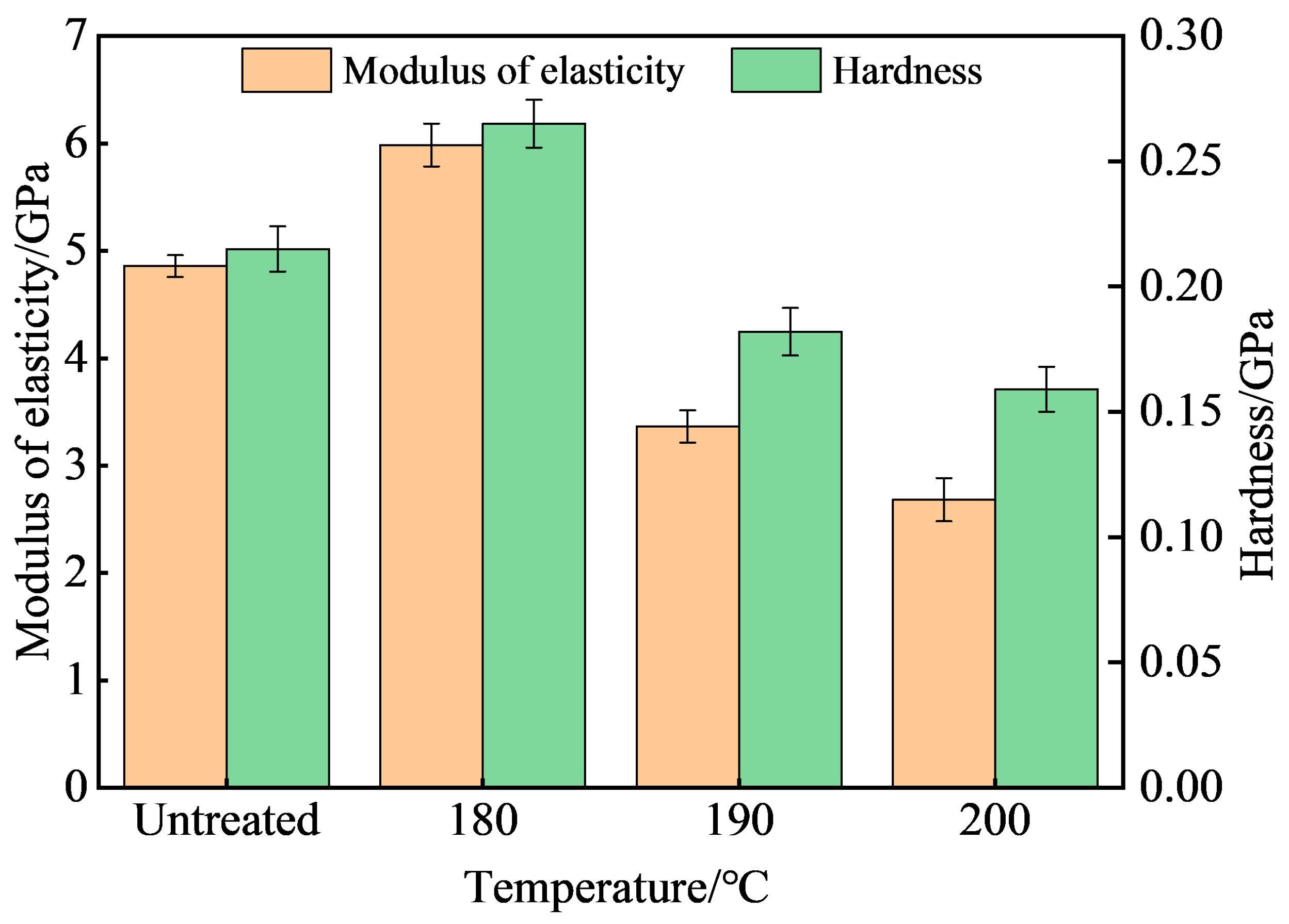Physical and Mechanical Properties and Microstructure Characterization of Thermally Modified Flattened Bamboo (Phyllostachys edulis) Material
Abstract
1. Introduction
2. Materials and Methods
2.1. Materials
2.2. Thermal Modification Process
2.3. Characterizations
2.3.1. Mechanical Performance
2.3.2. Dimensional Stability
Thickness Swelling Rate and Water Absorption Rate
Bending Height
2.3.3. FTIR
2.3.4. XRD
2.3.5. SEM
2.3.6. Nanoindentation
3. Results
3.1. Effect of Thermal Modification Treatment on Mechanical Properties of Flat Bamboo Lumber
3.2. Effect of Thermal Modification Treatment on Dimensional Stability of Flat Bamboo Wood
3.2.1. Thickness Swelling Rate and Water Absorption Rate
3.2.2. Bending Height
3.3. Effect of Thermal Modification Treatment on Infrared Spectral Properties of Flat Bamboo Wood
3.4. Effect of Thermal Modification Treatment on XRD Properties
3.5. Effect of Thermal Modification Treatment on Micro-Morphology of Flat Bamboo Wood
3.6. Effect of Thermal Modification Treatment on Nanomechanical Properties of Flat Bamboo Wood
4. Conclusions
Author Contributions
Funding
Data Availability Statement
Conflicts of Interest
References
- Shangguan, W.; Gong, Y.; Zhao, R.; Ren, H. Effects of heat treatment on the properties of bamboo scrimber. J. Wood Sci. 2016, 62, 383–391. [Google Scholar] [CrossRef]
- Liu, J.; Zhang, H.; Laurent, C.; Bin, N.; Lu, X. Study on a bamboo stressed flattening process. Eur. J. Wood Wood Prod. 2013, 71, 291–296. [Google Scholar] [CrossRef]
- Fang, C.H.; Jiang, Z.H.; Sun, Z.J.; Liu, H.R.; Zhang, X.B.; Zhang, R.; Fei, B.H. An overview on bamboo culm flattening. Constr. Build. Mater. 2018, 171, 65–74. [Google Scholar] [CrossRef]
- Li, D.; Yang, S.; Liu, Z.; Wang, Z.; Ji, N.; Liu, J. Effects of heat treatment under different pressures on the properties of bamboo. Polymers 2023, 15, 3074. [Google Scholar] [CrossRef] [PubMed]
- Yang, T.H.; Lee, C.H.; Lee, C.J.; Cheng, Y.W. Effects of different thermal modification media on physical and mechanical properties of moso bamboo. Constr. Build. Mater. 2016, 119, 251–259. [Google Scholar] [CrossRef]
- Cheng, D.; Jiang, S.; Zhang, Q. Effect of hydrothermal treatment with different aqueous solutions on the mold resistance of moso bamboo with chemical and FTIR analysis. BioResources 2013, 8, 371–382. [Google Scholar] [CrossRef]
- Zhang, Y.M.; Yu, Y.L.; Ji, Y.W. Effect of thermal treatment on the physical and mechanical properties of Phyllostachys pubescen bamboo. Eur. J. Wood Wood Prod. 2013, 71, 61–67. [Google Scholar] [CrossRef]
- Liang, X.; Yao, Y.; Xiao, X.; Liu, X.; Wang, X.; Li, Y. Pressure-Steam Heat Treatment-Enhanced Anti-Mildew Property of Arc-Shaped Bamboo Sheets. Polymers 2022, 14, 3644. [Google Scholar] [CrossRef]
- Yang, T.C.; Wu, T.L.; Yeh, C.H. Water resistance and creep behavior of heat-treated moso bamboo determined by the stepped isostress method. Polymers 2021, 13, 1264. [Google Scholar] [CrossRef]
- GB/T 15780-1995; Testing Methods for Physical and Mechanical Properties of Bamboos. China Standards Press: Beijing, China, 1995.
- GB/T 1941-1991; Method of Testing in Hardness of Wood. China Standards Press: Beijing, China, 1991.
- Tang, T.; Chen, X.; Zhang, B.; Liu, X.; Fei, B. Research on the physico-mechanical properties of moso bamboo with thermal treatment in tung oil and its influencing factors. Materials 2019, 12, 599. [Google Scholar] [CrossRef]
- Li, X.; Ye, H.; Han, S.; Li, M.; Lin, H.; Wang, G. Effects of bamboo nodes on mechanical properties of thin-type bamboo bundle laminated veneer lumber (BLVL): From anatomical structure to penetration mechanism. Ind. Crops Prod. 2023, 203, 117119. [Google Scholar] [CrossRef]
- Zhu, R.; Zhang, Y.; Yu, W. Changes in the chemical properties of Phyllostachys iridescens bamboo with steam treatment. Bioresources 2015, 10, 5987–5993. [Google Scholar] [CrossRef]
- Kolya, H.; Hasegawa, M.; Hashitsume, K.; Kang, C. Effects of Chemical and Physical Treatments on Bamboo Cell Wall Structure from Engineering Perspectives. Wood Res. 2024, 69, 272–282. [Google Scholar] [CrossRef]
- Chakkour, M.; Moussa, M.O.; Khay, I.; Balli, M.; Zineb, T.B. Effects of Humidity Conditions on the Physical, Morphological, and Mechanical Properties of Bamboo Fibers Composites. Ind. Crops Prod. 2023, 192, 116085. [Google Scholar] [CrossRef]
- Thwe, M.M.; Liao, K. Effects of environmental aging on the mechanical properties of bamboo–glass fiber reinforced polymer matrix hybrid composites. Compos. Part A Appl. Sci. Manuf. 2002, 33, 43–52. [Google Scholar] [CrossRef]
- Li, Z.; Luan, Y.; Hu, J.; Fang, C.; Liu, L.; Ma, Y.; Liu, Y.; Fei, B. Bamboo Heat Treatments and Their Effects on Bamboo Properties. Constr. Build. Mater. 2022, 331, 127320. [Google Scholar] [CrossRef]
- Tang, T.; Zhang, X.; Fei, B. Tung oil improves dimensional stability of flattened bamboo. Eur. J. Wood Wood Prod. 2023, 81, 1543–1555. [Google Scholar] [CrossRef]
- Huang, C.; Lin, W.; Lai, C.; Li, X.; Jin, Y.; Yong, Q. Coupling the post-extraction process to remove residual lignin and alter the recalcitrant structures for improving the enzymatic digestibility of acid-pretreated bamboo residues. Bioresour. Technol. 2019, 285, 121355. [Google Scholar] [CrossRef]
- Zhang, Y.; Yu, Y.; Lu, Y.; Yu, W.; Wang, S. Effects of heat treatment on surface physicochemical properties and sorption behavior of bamboo (Phyllostachys edulis). Constr. Build. Mater. 2021, 282, 122683. [Google Scholar] [CrossRef]
- Guo, J.; Song, K.; Salmén, L.; Yin, Y. Changes of wood cell walls in response to hygro-mechanical steam treatment. Carbohydr. Polym. 2015, 115, 207–214. [Google Scholar] [CrossRef]
- Altgen, M.; Hofmann, T.; Militz, H. Wood moisture content during the thermal modification process affects the improvement in hygroscopicity of Scots pine sapwood. Wood Sci. Technol. 2016, 50, 1181–1195. [Google Scholar] [CrossRef]
- Chen, H.; Zhang, Y.; Yang, X.; Ji, H.; Zhong, T.; Wang, G. A Comparative Study of the Microstructure and Water Permeability Between Flattened Bamboo and Bamboo Culm. J. Wood Sci. 2019, 65, 64. [Google Scholar] [CrossRef]
- Herrera, R.; Erdocia, X.; Labidi, J.; Llano-Ponte, R. Chemical analysis of industrial-scale hydrothermal wood degraded by wood-rotting basidiomycetes and its action mechanisms. Polym. Degrad. Stab. 2015, 117, 37–45. [Google Scholar] [CrossRef]
- Wu, Y.; Yang, L.; Zhou, J.; Yang, F.; Huang, Q.; Cai, Y. Softened wood treated by deep eutectic solvents. ACS Omega 2020, 5, 22163–22170. [Google Scholar] [CrossRef]
- Mohebby, B. Application of ATR Infrared Spectroscopy in Wood Acetylation. J. Agric. Sci. Technol. 2010, 10, 253–259. [Google Scholar] [CrossRef]
- Gabov, K.; Gosselink, R.J.; Smeds, A.I.; Fardim, P. Characterization of lignin extracted from birch wood by a modified hydrotropic process. J. Agric. Food Chem. 2014, 62, 10759–10767. [Google Scholar] [CrossRef]
- Chen, M.; Ye, L.; Wang, G.; Ma, X.; Chen, Q.; Fang, C.; Fei, B.; Dai, C. In-situ investigation of deformation behaviors of moso bamboo cells pertaining to flexural ductility. Cellulose 2020, 27, 9623–9635. [Google Scholar] [CrossRef]
- Wang, X.; Su, N.; Chen, X.; Fei, B.; Ma, X.; Liu, H.; Miao, H.; Fang, C. Impact of Temperature on Mechanical Properties and Dimensional Stability in a Novel Gradient Pressure Bamboo Flattening Technique. Constr. Build. Mater. 2024, 427, 136258. [Google Scholar] [CrossRef]
- Windeisen, E.; Strobel, C.; Wegener, G. Chemical changes during the production of thermo-treated beech wood. Wood Sci. Technol. 2007, 41, 523–536. [Google Scholar] [CrossRef]
- Wang, W.; Ma, W.; Wu, M.; Sun, L. Effect of water molecules at different temperatures on properties of cellulose based on molecular dynamics simulation. Bioresources 2022, 17, 269–280. [Google Scholar] [CrossRef]
- Chen, L.S.; Fei, B.H.; Ma, X.X.; Lu, J.P.; Fang, C.H. Effects of hygrothermal environment in cooling towers on the chemical composition of bamboo grid packing. Forests 2019, 10, 274. [Google Scholar] [CrossRef]
- Kadivar, M.; Gauss, C.; Mármol, G.; de Sá, A.D.; Fioroni, C.; Ghavami, K.; Savastano, H., Jr. The Influence of the Initial Moisture Content on Densification Process of D. asper Bamboo: Physical-Chemical and Bending Characterization. Constr. Build. Mater. 2019, 229, 116896. [Google Scholar] [CrossRef]
- Dai, L.; He, C.; Wang, Y.; Liu, Y.; Yu, Z.; Zhou, Y.; Fan, L.; Duan, D.; Ruan, R. Comparative study on microwave and conventional hydrothermal pretreatment of bamboo sawdust: Hydrochar properties and its pyrolysis behaviors. Energy Convers. Manag. 2017, 146, 1–7. [Google Scholar] [CrossRef]
- Ren, D.; Wang, H.; Yu, Z.; Wang, H.; Yu, Y. Mechanical Imaging of Bamboo Fiber Cell Walls and Their Composites by Means of Peakforce Quantitative Nanomechanics (PQNM) Technique. Holzforschung 2015, 69, 975–984. [Google Scholar] [CrossRef]
- Lee, C.H.; Yang, T.H.; Cheng, Y.W.; Lee, C.J. Effects of Thermal Modification on the Surface and Chemical Properties of Moso Bamboo. Constr. Build. Mater. 2018, 178, 59–71. [Google Scholar] [CrossRef]
- Huang, Y.; Fei, B.; Wei, P.; Zhao, C. Mechanical Properties of Bamboo Fiber Cell Walls During the Culm Development by Nanoindentation. Ind. Crops Prod. 2016, 92, 102–108. [Google Scholar] [CrossRef]








Disclaimer/Publisher’s Note: The statements, opinions and data contained in all publications are solely those of the individual author(s) and contributor(s) and not of MDPI and/or the editor(s). MDPI and/or the editor(s) disclaim responsibility for any injury to people or property resulting from any ideas, methods, instructions or products referred to in the content. |
© 2025 by the authors. Licensee MDPI, Basel, Switzerland. This article is an open access article distributed under the terms and conditions of the Creative Commons Attribution (CC BY) license (https://creativecommons.org/licenses/by/4.0/).
Share and Cite
Zheng, Y.; Liu, L.; Bao, M.; Lin, F.; Wu, X.; Li, Y.; Gong, Y.; Gu, W.; Zhang, W. Physical and Mechanical Properties and Microstructure Characterization of Thermally Modified Flattened Bamboo (Phyllostachys edulis) Material. Forests 2025, 16, 694. https://doi.org/10.3390/f16040694
Zheng Y, Liu L, Bao M, Lin F, Wu X, Li Y, Gong Y, Gu W, Zhang W. Physical and Mechanical Properties and Microstructure Characterization of Thermally Modified Flattened Bamboo (Phyllostachys edulis) Material. Forests. 2025; 16(4):694. https://doi.org/10.3390/f16040694
Chicago/Turabian StyleZheng, Yixuan, Lina Liu, Minzhen Bao, Feng Lin, Xujun Wu, Yanjun Li, Yan Gong, Weijie Gu, and Weigang Zhang. 2025. "Physical and Mechanical Properties and Microstructure Characterization of Thermally Modified Flattened Bamboo (Phyllostachys edulis) Material" Forests 16, no. 4: 694. https://doi.org/10.3390/f16040694
APA StyleZheng, Y., Liu, L., Bao, M., Lin, F., Wu, X., Li, Y., Gong, Y., Gu, W., & Zhang, W. (2025). Physical and Mechanical Properties and Microstructure Characterization of Thermally Modified Flattened Bamboo (Phyllostachys edulis) Material. Forests, 16(4), 694. https://doi.org/10.3390/f16040694




